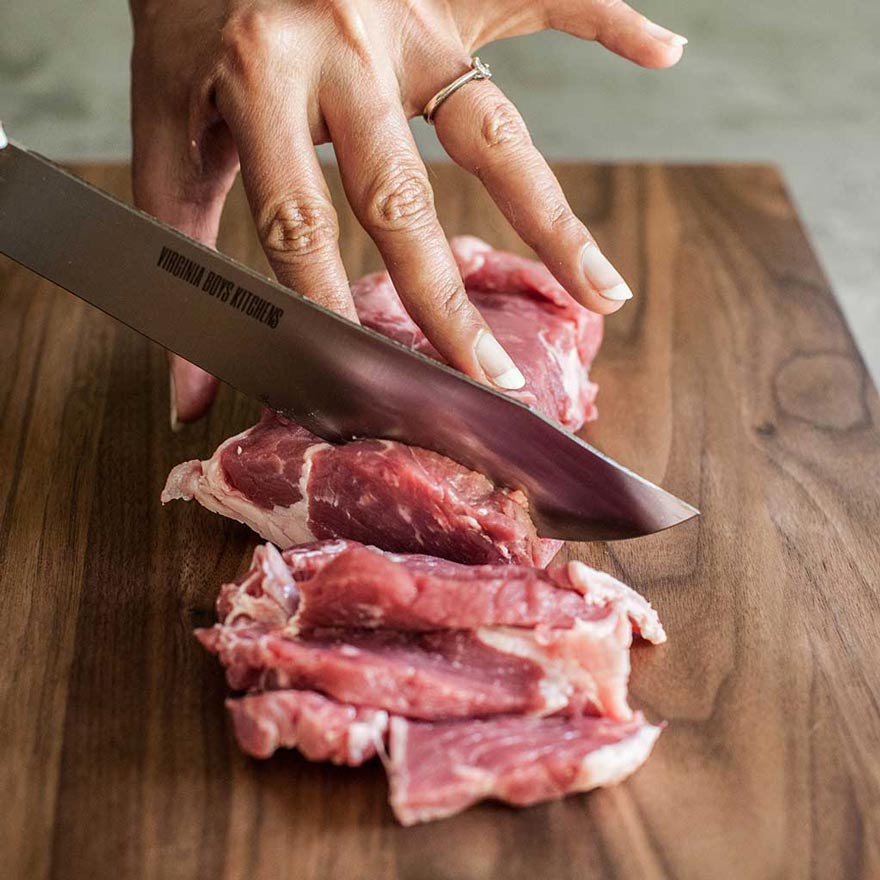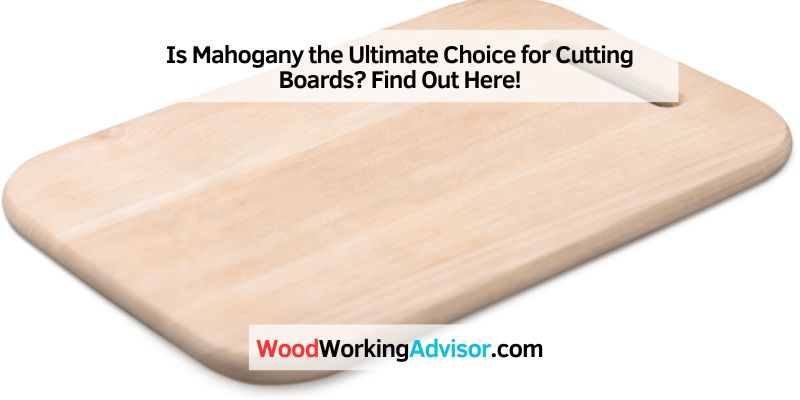Yes, mahogany is a good option for cutting boards due to its durability and natural resistance to moisture and bacteria. Mahogany’s strength and stability make it an ideal choice for kitchen utensils.
Its rich color and fine textures also add a touch of elegance to any kitchen decor. Additionally, mahogany’s tight grains prevent the growth of bacteria, making it a hygienic choice for food preparation. Its density and hardness make it resistant to knife marks, ensuring a long-lasting cutting surface.
Moreover, mahogany can be easily maintained by regular oiling and wiping, which helps to preserve its beauty and extend its lifespan. Overall, mahogany is an excellent material for cutting boards, combining functionality, aesthetics, and hygiene.
Benefits Of Mahogany For Cutting Boards
Mahogany is a popular choice when it comes to selecting a material for cutting boards. Its numerous benefits make it a preferred option for professional chefs and home cooks alike. Let’s explore some of the key advantages of using mahogany for cutting boards.
Durable And Long-lasting
One of the remarkable benefits of mahogany is its incredible durability and longevity. With its dense and sturdy nature, a mahogany cutting board can withstand heavy chopping and slicing without showing signs of wear and tear. This characteristic is essential for a cutting board as it ensures your board stays intact and remains a reliable kitchen companion for years to come.
Resistant To Moisture And Bacteria
Another advantage of mahogany as a cutting board material is its resistance to moisture and bacteria. Due to its natural oils and tight grain structure, mahogany is highly resistant to water absorption. This quality makes it less prone to warping or swelling when exposed to moisture, which is a common issue with many other types of wood. Additionally, mahogany’s inherent antibacterial properties help inhibit the growth of harmful microorganisms, thus ensuring a hygienic food preparation surface.
In conclusion, the benefits of mahogany for cutting boards are evident. Its durability and longevity make it a reliable kitchen tool that can withstand rigorous use. Its resistance to moisture and bacteria provides a safe and clean surface for food preparation. For those looking for a high-quality and long-lasting cutting board, mahogany is an excellent choice.

Credit: birchbarndesigns.com
Challenges Of Using Mahogany For Cutting Boards
Mahogany, known for its beautiful color and texture, is a popular choice for furniture and decorative items. However, when it comes to using mahogany for cutting boards, there are certain challenges that need to be considered. The hardness and maintenance requirements as well as the cost implications are important factors to bear in mind.
Hardness And Maintenance
Mahogany is a relatively soft wood with a Janka hardness rating of around 800. While this may be sufficient for some cutting board applications, it may not be ideal for heavy-duty cutting and chopping. Harder woods like maple or bamboo are better suited for those tasks as they are more resistant to knife marks and scratches.
In terms of maintenance, mahogany requires regular oiling and conditioning to keep it moisturized and protected from moisture damage. Failure to do so can result in the wood drying out, cracking, and potentially warping over time. This means that mahogany cutting boards will require more attention and care compared to other types of wood.
Cost Considerations
Mahogany is a high-quality wood that is often associated with luxury and craftsmanship. As such, it tends to be more expensive compared to other woods commonly used for cutting boards. The cost of mahogany can vary depending on factors such as the grade and origin of the wood, but it is generally considered to be on the higher end of the price spectrum.
Therefore, if budget is a consideration, opting for other hardwoods like maple or cherry may be a more cost-effective choice without compromising on quality or durability. These woods offer similar hardness and maintenance requirements at a more affordable price point.
In conclusion, while mahogany can certainly be used for cutting boards, it does come with its challenges. Its relatively soft nature and higher maintenance needs make it less suitable for heavy-duty tasks. Additionally, the higher cost compared to other hardwoods should be carefully considered. Ultimately, the choice of wood for a cutting board should be based on personal preferences, needs, and overall requirements.
Comparison Of Mahogany With Other Cutting Board Materials
When it comes to selecting the best material for cutting boards, Mahogany is often a top contender. However, it’s essential to consider how it fares when compared to other popular materials like Bamboo and Maple. Let’s delve into the comparison of Mahogany with these cutting board materials to determine its suitability.
Versus Bamboo
Bamboo cutting boards have gained popularity for their eco-friendly and sustainable properties. These boards are lightweight, durable, and resistant to moisture, making them a practical choice for use in the kitchen. However, when it comes to hardness, Mahogany surpasses Bamboo, providing a more sturdy surface that is ideal for cutting and chopping tasks. Moreover, Mahogany’s natural oils help in preserving the board, making it less prone to bacteria growth compared to Bamboo.
Versus Maple
On the other hand, Maple cutting boards are renowned for their durability and attractive appearance. Maple offers a tough cutting surface that can withstand heavy usage. Although Mahogany may not be as dense as Maple, it still provides a robust and reliable cutting surface. Additionally, Mahogany’s rich and warm hues add an elegant touch to the kitchen, distinguishing it from the lighter tones of Maple.

Credit: virginiaboyskitchens.com
Tips For Caring For Mahogany Cutting Boards
Mahogany cutting boards are not only beautiful but also versatile and durable. However, like any other cutting board, they require proper care and maintenance to ensure their longevity. In this section, we will discuss some essential tips for cleaning and maintaining your mahogany cutting board so that it stays in optimal condition for years to come.
Proper Cleaning Techniques
Keeping your mahogany cutting board clean is crucial for preventing the growth of bacteria and maintaining its appearance. Here are a few simple cleaning techniques:
- Wash the cutting board immediately after use with hot, soapy water. Ensure you scrub it gently to remove any food particles.
- Dry the cutting board thoroughly after washing, as excess moisture can cause the wood to warp or crack.
- Avoid submerging the cutting board in water or putting it in the dishwasher, as this can damage the wood.
- Occasionally disinfect the cutting board by using a mixture of equal parts water and white vinegar or a food-safe disinfectant spray. Let it sit for a few minutes, then rinse and dry it thoroughly.
Maintenance And Oil Treatments
Regular maintenance and oil treatments can help preserve the quality and appearance of your mahogany cutting board. Here are some tips to follow:
- Apply a thin layer of food-grade mineral oil or beeswax regularly to protect the wood from moisture and prevent it from drying out.
- Using a soft cloth, rub the oil or wax into the surface of the cutting board, ensuring complete coverage.
- Let the oil or wax sit for a few hours or overnight to allow it to penetrate the wood.
- Wipe off any excess oil or wax with a clean cloth.
- Repeat this process every few months or as needed to maintain the board’s integrity.
Following these simple tips will help keep your mahogany cutting board in excellent condition, ensuring its longevity and allowing you to enjoy its beauty and functionality for years to come.
Conclusion And Final Thoughts
Wondering whether mahogany is suitable for cutting boards? In conclusion, mahogany is an excellent choice due to its durability and natural resistance to moisture and bacteria. Moreover, it boasts an attractive appearance, making it an ideal option for both functionality and aesthetics.
Considerations For Choosing A Cutting Board Material
Before we dive into the verdict on mahogany as a cutting board material, let’s take a moment to consider the factors to keep in mind when deciding which material to choose for your cutting board.
- Knife-Friendliness: A good cutting board should be kind to your knives, helping them retain their sharpness for longer periods of time.
- Resistance to Moisture: As a cutting board is often exposed to water and other liquids, it’s important to select a material that won’t easily warp or become damaged.
- Hygiene and Safety: Cutting boards should be easy to clean and maintain to ensure food safety. Some materials are more prone to harboring bacteria than others.
- Durability: A cutting board should be sturdy enough to withstand daily use, resisting scratches and cuts.
- Aesthetic Appeal: While not essential for functionality, the visual appeal of a cutting board can be an added bonus.
The Verdict On Mahogany
After considering the above factors, it’s time to assess whether mahogany makes a good choice for a cutting board. Here’s what you need to know:
| Factor | Mahogany |
|---|---|
| Knife-Friendliness | Mahogany is a hardwood with a dense grain, allowing knives to glide smoothly without dulling the edges excessively. |
| Resistance to Moisture | Mahogany has natural oils that make it resistant to water damage, reducing the likelihood of warping or bacterial growth. |
| Hygiene and Safety | As long as properly cleaned and maintained, mahogany cutting boards can be hygienic and safe for food preparation. |
| Durability | Mahogany is a durable wood that can withstand regular use and resist scratches, making it a long-lasting choice for cutting boards. |
| Aesthetic Appeal | Mahogany’s rich, reddish-brown hues and natural beauty make it an attractive option for those seeking an elegant cutting board. |
Considering all these factors, mahogany appears to be an excellent choice for a cutting board material. Its knife-friendliness, resistance to moisture, durability, and aesthetic appeal make it a top contender. Of course, personal preferences and priorities may vary, so it’s ultimately up to you to decide what suits your needs and style best.
Frequently Asked Questions On Is Mahogany Good For Cutting Boards
Is Mahogany Safe For A Cutting Board?
Yes, mahogany is safe for use as a cutting board.
Can Mahogany Be Used For A Butcher Block?
Yes, mahogany can be used for a butcher block. It is a durable and attractive option.
What Is the Best Wood For Cutting Board?
The best wood for a cutting board is maple, walnut, or cherry. These hardwoods are durable, less porous, and won’t dull knives. They also have natural antimicrobial properties, making them safe for food preparation. Regular oiling can maintain their quality and prolong their lifespan.
What Material Is Not Recommended For Cutting Boards?
Avoid using materials such as glass, marble, or metal for cutting boards. These materials can damage knives and dull the blades. Stick with cutting boards made from wood or plastic for optimal knife protection and longevity.
Conclusion
In crafting cutting boards, mahogany offers durability and beauty, making it a great choice. Its natural oils protect against water damage and bacteria, enhancing kitchen safety. With proper maintenance, mahogany cutting boards can last for years, making them a sustainable and reliable option for any kitchen.
Choose mahogany for quality and longevity in your kitchen tools.


